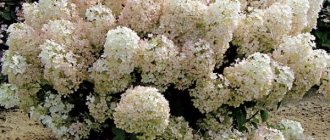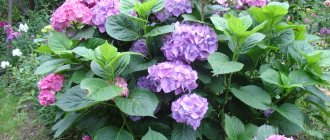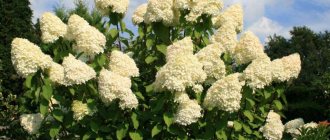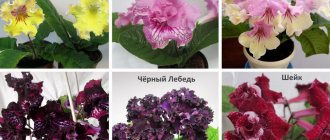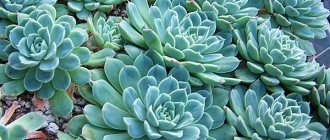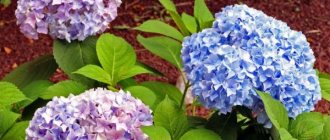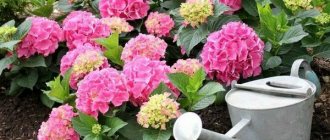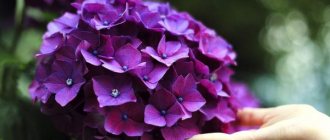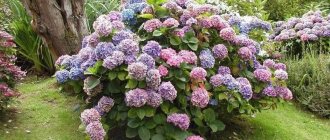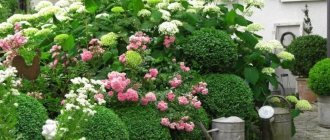Hydrangeas have always been a favorite ornamental plant for any style of garden design. They are planted everywhere by gardeners - from hedges to neat potted plants. If you're new to gardening, Hydrangea paniculata is a great flowering perennial plant for new gardeners to grow. They bloom for a very long time, are easy to care for and adapt to a wide range of climate conditions. In this article, we will provide a detailed guide to growing this ornamental shrub.
Description of the flower shrub Hydrangea paniculata
This species was first described in 1861 by Philipp Franz von Siebold, a German physician and renowned plant collector. This flowering shrub can be found in nature in the cool temperate and subtropical regions of Japan, China and on Sakhalin Island.
Among the entire species composition of the genus Hydrangea, it is Hydrangea paniculata or G. paniculata that most often grows in the form of an erect deciduous shrub 1.8 - 3 meters high and wide, with curved branches. But some varieties can also develop into a small branched tree 3 - 6 m tall.
The leaves of the plant are dark green, elliptical, 7-15 cm long, located opposite each other on the stem, although whorls of three leaves may form on the branches.
Hydrangea paniculata flowers are either sterile or fertile. Each flower panicle consists of small fruiting flowers of a yellowish-white hue and large showy sterile inflorescences framed by showy petal-like sepals. They change color as fall approaches, gradually turning pink and eventually brown. The flowering season of Gotrensia paniculata is from the second half of summer to September and beyond.
Depending on the variety and season, the colors of the flowers change. The flowers bloom in white or cream, changing to pink or red as the days get shorter and the nights get cooler as autumn approaches. In mid-autumn the petals turn brown and can persist throughout the winter.
Unlike other species of the genus Hydrangea, Hydrangea paniculata changes the color of its flowers due to its natural characteristics, lower temperatures and the maturation of the bush. The color of flowers of this species cannot be changed by changing the acidity (pH) of the soil.
Currently, more than 50 cultivated varieties of this species have been bred in nurseries. Most of them are very popular among gardeners and flower lovers.
When to plant a seedling?
Planting times depend on the region of residence and the plant variety. For example, paniculate hydrangea is planted in early autumn - in September. Residents of the southern regions can postpone planting to a later date. The most important thing is to plant young bushes before the first frost. If we are talking about large-leaved hydrangea, then it is unlikely to survive the autumn planting safely, so it is better to plant it in the spring.
Planting Hydrangea paniculata in open ground
The tree species of Hydrangea is quite easy to grow and can grow in harsh conditions. What do you need to know before planting shrub seedlings?
Soil requirements
This ornamental plant is not picky about the composition of the soil, as long as it is rich in organic matter and well-drained. The shrub can grow well in acidic and slightly alkaline soils. Many inexperienced gardeners often wonder: is it possible to grow Hydrangeas paniculata on clay soils? Yes, provided the soil is well drained and does not remain wet for a long time.
Some varieties may have their own requirements for soil composition. You need to ask the seedling sellers about this.
Lighting requirements
Hydrangea paniculata thrives in a few hours of sunlight, especially during flowering season. In good light, the shrub will bloom beautifully and profusely.
In more southern, hotter climates, it should be provided with shade in the afternoon. The plant is also well suited for light partial shade, but may die in a heavily shaded area of the garden.
Temperature and humidity
These plants have excellent frost resistance compared to many other types of Hydrangeas. During the dry season, it is important to water the plant well to prevent heat stress. Moisture is usually not a problem as long as proper watering is maintained.
You might be interested
The best perennial bush flowers for the garden: features and selection rules
The best 30 varieties of Hydrangea paniculata with names and photos
The best shrubs for hedges
How to plant Hydrangea paniculata seedlings
For planting, it is better to choose three- or four-year-old seedlings. Before purchasing, inspect them for damage to the root system and the general condition of the bush.
Additionally, consult with the seller regarding the growing conditions for this variety.
The optimal time for planting Hydrangea is the beginning of spring, after the end of frost. If your region has warm winters, you can plant seedlings in the fall.
How to properly plant Hydrangea paniculata:
- Dig a hole twice the size of the seedling's root ball. The hole must first be well moistened. If your soil is clayey, it is worth laying a layer of drainage at the bottom of the hole - fine expanded clay will do.
- Prepare an earth mixture by mixing a bucket of garden soil extracted from the hole, high-moor peat (2 liters) and vermicompost (also 2 liters). You can also add hydrogel, which will retain moisture longer between waterings (good for drier climates). Clay soil can be loosened by adding a little vermiculite to the mixture.
- Fill the planting hole halfway with the prepared soil mixture.
- We pull the seedling out of the container and place it together with the earthen ball in the hole.
We fill the voids with our soil mixture. - We compact the planting site, simultaneously forming a depression around the seedling for watering.
- The planting site must be watered abundantly and be sure to be mulched (the simplest mulch option is pine needles or small spruce branches).
- Vermicompost can be replaced with complex fertilizer for Gothensias or for seedlings. You should not add manure or humus, otherwise the root system of the seedlings will rot.
Some gardeners recommend adding fallen pine needles to the planting mixture instead of peat in a 50/50 ratio.
If you want to plant several Hydrangeas paniculata in a row, you need to know the size of an adult plant of this variety. This is necessary to determine the distance between the planting holes. This distance will be equal to the width of an adult bush.
Conditions for autumn planting
Be sure to keep in mind that you need to plant hydrangea no later than 3-4 weeks before the onset of stable frosts - penetrating into the soil to a depth of 10-15 cm. Perhaps this is the only thing that can cause inconvenience. Otherwise, autumn planting of paniculate hydrangea has only advantages:
- Favorable air and soil humidity
- No heat or drought
- Autumn rains as natural watering
- Comfortable air temperature
- First flowering next spring
Further care for paniculata hydrangea
In the first year, you need to pay a little attention to your bushes until they get stronger. Afterwards it will be much easier to care for them. What you need to know about caring for a flowering plant - read our tips.
Moisturizing Hydrangea paniculata
Woody shrubs do well in slightly moist soil. Be careful not to overwater as this can cause root rot and other diseases. On the other hand, letting the soil dry out too much can cause the foliage to wilt and ultimately damage or kill the plant.
Fertilizer
You should start feeding your flower plants at the beginning of the growing season. In garden centers you can find a well-balanced fertilizer prepared specifically for Hydrangeas, with the addition of microelements necessary for the flower. In spring, you can use fertilizers with a large amount of nitrogen.
Mulching
Spread a 5-7cm layer of organic mulch under each Hydrangea paniculata. Chopped leaves, tree bark or shavings, pine needles, and peat moss are suitable. Mulch will prevent weeds from germinating and help maintain soil moisture. In winter, it will protect the roots of the bush in winter from heaving of the soil, which is subject to alternate freezing and thawing. It is preferable to use pine needle mulch; it will additionally acidify the soil around the plants.
Pruning Hydrangea paniculata
By proper pruning, this plant can be shaped into a small tree or a compact shrub with many flowering stems. Many gardeners choose another option.
In the photo, Hydrangea paniculata in the form of a shrub and tree
How to prune a woody plant?
- Formation of shrubs . Flowering occurs on the current season's growth, so do some formative pruning as needed in early spring. The bush will produce larger clusters of flowers if you thin it back to five to ten main stems, no more. Remove excess side shoots and dead branches.
- Tree formation . To do this, select one main stem. Trim competing stems. Starting at ground level, remove all shoots that grow from the main stem to about three-quarters of its height. Constantly check for shoots at the base of the plant and remove them as they appear. Your main stem will continue to grow along with the foliage above, taking on the appearance of a trunk. It may take two or more years for the tree to mature.
In addition, in early spring we recommend trimming the entire plant to about a third of its total height. You can also remove any thin side branches, as well as any wood that is not showing signs of life.
Transfer
If you need to move the shrub to another place, replanting does not require much effort. This should be done in summer or early autumn. Start by trimming the roots before repotting to reduce the effects of stress.
- A couple of days before replanting, use a shovel to cut a small circle around the stems of the bush, cutting off the longer roots.
- Prepare the planting hole as described above.
- Carefully dig up your bush, trying to minimally disturb the root system. It is not advisable to remove old soil from the roots. Further actions are similar to planting a seedling.
- When repotting, make sure the plant is well hydrated.
Hydrangea paniculata care calendar
- Early spring . If desired, prune as above. Feed plants with a fertilizer high in nitrogen and phosphorus (such as 15-30-15) to encourage growth and future flowering. Finish replanting before the leaves bloom.
- Mid spring . Mulch plants after the soil begins to warm to maintain moisture and reduce ground temperatures. Monitor for powdery mildew and treat if necessary.
- Summer . Regular watering is mandatory at the beginning of summer, when Hydrangea uses the most water. In the middle of the season, hydrangeas begin to bloom. It is worth feeding the bush and monitoring soil moisture.
- Hydrangea paniculata in autumn . Flowering is over, but brown flowers still remain on the stems. Here you can decide what to do next - cut off the faded stems or leave them for the winter, bringing zest to the winter garden. There is no need to fertilize.
- Winter. If your shrub blooms in the first year, it is advisable to cut off all faded inflorescences so that the young stems do not break under the weight of snow.
Photo of a bush with dried flowers in winter (flickr.com)
Before winter frosts, you need to mulch the roots with pine needles or spruce branches.
Hydrangea propagation methods
Buying hydrangea seedlings is expensive, so this amazing crop is not so often found in private gardens. Not everyone knows that there is the possibility of vegetative propagation of plants in several ways. The most popular of them are:
- division;
- cuttings;
- layering.
Each of them requires detailed consideration.
By division
The simplest method, which does not cause any difficulties even for novice gardeners, is dividing the bush, which involves performing the following steps:
- digging and inspecting the bush;
- cutting the root with a knife;
- processing of cuts with brilliant green or charcoal;
- planting each part in the prepared hole;
- backfilling the roots with a mixture of soil and peat;
- watering the holes, which will need to be done regularly.
To obtain a guaranteed result, the event is best carried out in the spring.
Cuttings
The green cutting method can be used at the moment the buds appear. This period most often occurs in mid-July. Cuttings are parts of the stem with large buds, cut from the side shoots of young plants. The side shoot should be strong and have 2-3 pairs of leaves, the lower ones are removed, the rest are shortened by half. Then:
- in the lower part the cuttings are cut at an angle of 45 degrees;
- in the upper part a cut is made at an angle of 90 degrees;
- the stems are placed in a solution with a root growth stimulator, so as not to affect the leaves;
- the finished cuttings are planted in the ground 2-3 cm deep, maintaining a distance between them of 5 cm;
- moisten the upper part of the plant with a spray bottle;
- place the container with the cuttings in the greenhouse;
- Condensation is removed from plants with napkins daily;
- Water at least once a week.
After about a month, the rooted plants are transplanted into pots and grown until next spring.
By layering
Propagation by layering is best done before buds open in early spring. The essence of the method is to bend and strengthen the lower shoots of the plant in the holes, which are lightly sprinkled with a mixture of soil and peat and watered regularly.
Reference! For strengthening, staples or specially made slingshots are used.
On the cuttings, roots will form and new shoots will form. It will be possible to plant the plants next year by assigning them a separate place in the garden.
How to propagate Hydrangea paniculata
The best option is cuttings. The branch should be free of flowers and ideally at least 15 cm inches long. Remove leaves from the lower half of the stem.
- Fill a container with drainage holes with a soilless mixture of 80 percent moistened peat moss and 20 percent perlite.
- Dip the cutting in rooting hormone powder and stick it into a pot of well-drained potting mix.
- Stick the cutting into the pot 5 cm deep. Cover the pot with film to maintain the microclimate in the container, but make sure that the cover does not touch the cutting itself. Stick a few sticks around the cuttings in the pot so that the covering does not touch the seedling.
- Place the pot in a warm place with indirect sunlight. Keep the potting soil slightly moist.
- Hydrangeas take root very quickly; within two to three weeks the cuttings should send out roots into the ground.
- Keep rooted plants indoors or in a greenhouse during their first winter.
- Next year, take the plants outside for the spring and summer and don’t forget to water them. Bring them back indoors for another winter before the first frost.
You can confidently plant them in the garden in their third year, in spring or fall.
Summer cuttings are also practiced, in which the cuttings are planted directly in open ground. You can learn more about this type of propagation and some tips for indoor propagation in this video
Reproduction by lateral branches
- Select a healthy branch from the outside of the bush and bend it to see if it reaches the ground.
- Remove leaves where the branch will touch the ground. Carefully remove the bark of the branch with a knife where it touches the ground.
- To speed up the rooting process, sprinkle the cleaned area with Kornevin.
- Dig a small groove 7 cm deep in the ground. Gently bend the branch to the ground and place it in the groove, pressing the end with a stone or something heavy.
- Cover the branch with soil, leaving the top exposed. Leave the cuttings alone to allow the roots to develop and don't forget to water.
- When signs of rooting and new growth appear, the branch can be cut off from the parent bush.
Separating a young plant from its parent can be a shock to the seedling, so leave it in the ground for a few more weeks until it is at least 10cm tall. After separating the young shoot, you can dig it up for replanting.
How to choose good seedlings
To purchase hydrangeas, you should go to a nursery or large garden center. There are two types of seedlings on sale - with an open and closed root system. When choosing, you need to carefully examine the plant, paying attention to its appearance and the condition of the root system:
- If the seedling is sold in a container, it can be partially pulled out to assess the condition of the roots.
- The root system should not show signs of decay or traces of mold. If you smell a musty smell, the sellers may have removed the moldy deposits in advance; it is better to put this item aside.
- The roots should not be overdried.
- Please ensure that there are no cracks or mechanical damage on the bark and shoots.
- It is better to choose seedlings with a developed root system; the roots peeking out of the drainage hole will indicate this.
In cases where it is not possible to plant the shrub directly in open ground, you can temporarily place the hydrangea in a large container with acidic soil and keep it in the coolest place. After the temperature outside exceeds 10 degrees, the seedling is placed on the balcony, where it is kept until planting.
Diseases and pests of Hydrangea paniculata
The most likely disease that can appear on a shrub is leaf spot. It is caused by a fungus. Although the foliage may look unsightly, spotting does not harm the plant. This disease only appears in the leaf tissue, so after the leaves fall in the fall, it no longer affects the plant. Be sure to remove fallen leaves from the area (fungal spores will overwinter on them).
Pests
Insects generally rarely attack Hydrangea, although some beetles may nibble on the leaves. They usually do not affect flowers, and small numbers of insects feeding on leaves are not a problem. You may notice minor slug damage to leaves, which is recognizable by the irregular, uneven appearance and slime on the leaf surface, especially on young plants.
Sheltering hydrangeas for the winter
In cold regions with harsh winters, it is important to ensure reliable protection of the young plant from severe frosts and cold. To do this, remove the remains of leaves and inflorescences, add mulch to the hole and center of the bush, using spruce branches, pine bark, moss, rotted sawdust, peat or leaf humus. The thickness of the mulch layer should be at least 15-20 cm. The shoots of the bush should be covered: tied with twine and wrapped in burlap. These measures will prevent damage to the plant by wind, snow, rain or hail and protect the root system from freezing.
Hydrangea is a beautiful and unusual plant that can become a real decoration of park areas, private gardens and personal plots. There are more than 80 varieties of hydrangeas in the world that are resistant to cold and have a long flowering period. This type of shrubs, trees and vines is gaining popularity among gardeners due to its unpretentiousness and aesthetically attractive appearance. In nature, you can find hydrangeas of a wide variety of colors, many of which have the ability to change shade during the flowering period. In addition to garden varieties, breeders have developed types of hydrangeas that can be grown indoors.
Hydrangea paniculata in garden landscape design
Due to its frost resistance, this plant perfectly complements the landscape at any time of the year. He continues to delight us with flowers, even when other plants have already faded.
The plant can be shaped into a large tree and used as a focal point. Shrubs can be used as hedges. Hydrangea goes well with other perennial flowering plants.
Beautiful cone-shaped flowers will also be a wonderful addition to any bouquet, either in a composition with other flowers or alone.
Choosing a site for planting: what to look for?
It is best to plant paniculate hydrangea in a well-lit place without drafts. Planting in partial shade is also possible. But it is not recommended to “attach” it in complete shade. Otherwise, the plant will not reveal all its beauty. The inflorescences will be small and dull. Hydrangea can be placed near a fence, on an alpine hill, a flower bed or in the middle of a lawn as a single planting. But it is advisable to plant a young plant in the trunk circles of large trees. In this case, a real competition for moisture will arise between the hydrangea and the tree. The bush will feel great if planted separately from other plants. But there is an exception. For example, paniculate hydrangea gets along quite well with mock orange, spirea and lilac.
Soil requirements
Hydrangea prefers fertile and nutritious soil. The soil should be slightly acidified and easily absorb water. Neutral or alkaline soil is not suitable. The shrub will be sick, suffer from iron deficiency and this will negatively affect the quality of flowering. Therefore, liming of the soil is under no circumstances carried out. On the contrary, it needs to be acidified.
